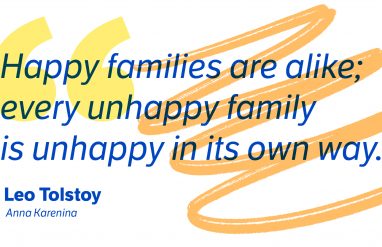During the month of Ramadan, followers of Islam around the world partake in fasting. No food or drink is consumed during the daylight hours for 30 straight days.
People who partake are far from alone. In fact, fasting plays an important role in many religions, as well as in diets and forms of protest.
Regardless of the purpose, there’s a couple of questions that relate to all forms of fasting: What’s so fast about fasting? And is fasting at all related to fast as in “quick” or “firmly fixed in place”?
What is a fast?
To fast is a verb that means “to abstain from all food,” or “to eat only sparingly or of certain kinds of food, especially as a religious observance.” Someone can fast for a week, for example, or you could say that someone who isn’t eating for a period of time is fasting.
Fast can also be used as a noun in the sense of “a day or period of fasting,” as in the devout followers observed a two-day fast.
What the definition doesn’t specify is how long of an abstinence is required before it’s considered a fast. Still, the word is generally used to refer to not eating for a big portion of the day rather than fasting for a matter of minutes—you know, the time in between snacks.
Though this literal meaning is directly tied to food and eating, it’s common for people to use fast in metaphorical ways as well. People can say that they’re fasting when it comes to pretty much anything that has to do with consumption. One can go on a social media fast to prove they don’t really need to check their social accounts every 30 minutes, for instance. When used in this context, the person fasting typically refrains from using something that is considered a habit or harmful when done too compulsively.
Why do we use the term breakfast?
Even English speakers who think they’ve never used fast in a sentence are actually frequent users of the word. You’ve likely had the aha! moment when you noticed yourself using fast in a very specific setting: breakfast.
Breakfast is a compound made up of the words break and fast, and the meaning is just as straightforward. It’s such a familiar (and delicious) word we seldom stop to think about what it means when you take it apart! Quite literally, when you eat in the morning, you are breaking your fast from when you were sleeping the night before, whether that was an eight-hour sleeping fast or a 12-hour fast. (Were you sleeping in a little bit?)
Where does the word fast come from? Does it originally mean “speedy”?
Fast comes from the Old English word fæstan. It’s a cognate of similar words in Germanic languages, like the German fasten and Old Norse fasta.
Like run, fast is one of those words with a wide range of meanings. In fact, understanding what someone means when they say fast largely depends on context. Fast can be an adjective meaning “quick,” as in cheetahs are fast, as well as an adverb meaning “quickly” or “done in a short amount of time,” as in the medicine is working very fast.
Then there are the other meanings of fast that have nothing to do with speed. Fast can be used as an adverb in the sense of “holding tightly,” like a boat held fast to the dock. Fast can also mean “soundly,” as in someone who is fast asleep. These uses are closely related to steadfast, another fast compound which means “firmly attached,” “permanent,” and “not fluctuating.” In fact, etymologists believe that they are, in fact, all ultimately related. Underlying the word’s many meanings are such ideas as stability, groundedness, security, fixedness.
And indeed, the ancient, root sense of fast is believed to be “holding firm” or “guarding.” You can imagine this original meaning was extended to “firmly fixed in place.” The sense development of this root to “quick” is more obscure; it may have risen out of some notion of a vigor or tenacity within “holding firm.” Finally, fasting is thought to have grown out of “holding firm” in religious observances or duties, which historically involved abstaining from food in ritualistic ways.
Why do people fast around the world?
Fasting is a common theme across the world’s major religions and cultures. During Ramadan, observers of Islam abstain from food and drink from sunrise to sunset for about 30 days. Catholics and some sects of Christianity fast for 40 weekdays leading up to Easter for Lent. Though fasting was once a central part of Lent and observers used to eat only one meal a day (and no meat, eggs, or butter), people now fast to varying degrees. Roman Catholics, for example, abstain from meat on the first day of Lent (Ash Wednesday), the Friday before Easter (Good Friday), and every Friday during the seven weeks of Lent. People in other sects of modern Christianity may give up something they view as valuable or enjoyable, like chocolate or coffee or even video games, rather than fast.
Fasting has long been a part of religious observances, as well as health practices. The Greek physician Hippocrates recommended fasting for people who were ill. Various fasting methods were prescribed throughout the 20th century as a way to get over certain chronic illnesses.
When it comes to religion, ancient Greek priests and priestesses fasted for deities. Indigenous peoples in what is now Peru fasted for penance and fasting took place before religious vision quests elsewhere in the Americas. Buddhist monks fast for meditation and there are a number of fasting days in Judaism, like Yom Kippur. The exact reasons for the fast differ by religion and culture, but it’s generally a way to get closer to gods and deities. For example, in the Bible, fasting is used as a way to show repentance and deny oneself the comforts of life, instead relying on God alone for strength.
What is a hunger strike?
There’s also another reason that people fast that has nothing to do with religion or health: fasting in protest or to raise awareness of an issue. Mahatma Gandhi fasted to protest colonial rule in India, and people who are imprisoned have long used hunger strikes to call attention to prison conditions. The term hunger strike dates back to the early 1900s and is defined as “a deliberate refusal to eat, undertaken in protest against imprisonment, improper treatment, objectionable conditions.”
American military veterans fasted in protest of President Ronald Reagan’s policies, and Reagan himself declared November 24, 1985 the National Day of Fasting To Raise Funds To Combat Hunger.
What is intermittent fasting?
Fasting has become a part of a popular wellness trend, too, thanks to intermittent fasting. Intermittent fasting is when someone fasts for a set period of time during the day to lose weight. Noncaloric drinks like water, coffee, and tea are allowed during the fasting periods, but no food. It’s essentially a dieting tactic that focuses on eating at certain times rather than dictating exactly what a person is supposed to eat.
It should be noted that intermittent fasting is built into life itself—see: breakfast. When people talk about intermittent fasting, they’re referring to fasting that’s “alternately ceasing and beginning again.” However, they’re not referring to the natural fast of sleeping and breaking that fast in the morning. One of the most popular intermittent fasting schedules is the 16/8 method (16 hours of fasting, eight hours of not fasting).
Outside of religious and health reasons, many people won’t be so fast to jump into fasting. Food lovers, for one, are sure to hold fast to enjoying their meals and snacks whenever, wherever. Yet at the end of the day, fasting is a part of every person’s life, as is breaking that fast in the morning.













